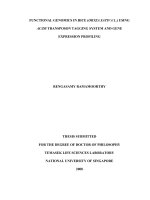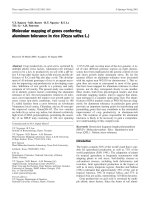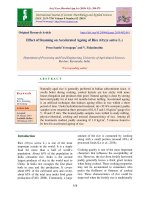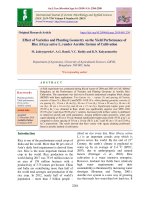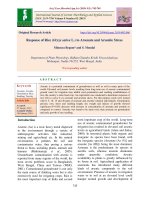Functional genomics in rice (oryza sativa l) using ac ds transposon tagging system and gene expression profiling
Bạn đang xem bản rút gọn của tài liệu. Xem và tải ngay bản đầy đủ của tài liệu tại đây (3.35 MB, 239 trang )
FUNCTIONAL GENOMICS IN RICE (ORYZA SATIVA L.) USING
AC/DS TRANSPOSON TAGGING SYSTEM AND GENE
EXPRESSION PROFILING
RENGASAMY RAMAMOORTHY
THESIS SUBMITTED
FOR THE DEGREE OF DOCTOR OF PHILOSOPHY
TEMASEK LIFE SCIENCES LABORATORY
NATIONAL UNIVERSITY OF SINGAPORE
2008
ii
DEDICATED TO MY FAMILY AND FRIENDS
iii
ACKNOWLEDGEMENTS
I came to Singapore in August 2000 to work in the Rice Functional genomics
laboratory at Institute of Molecular Agrobiology (IMA) as an assistant research officer
(ARO). Later I started my PhD project in August 2002 at Temasek Life Sciences
Laboratory (TLL) and I am very glad today that I could finish my project in appropriate
time with the satisfactory outcome of my thesis. This was achieved with collaborative
efforts by many people and I would like to acknowledge my sincere thanks to them.
I would like to express my profound gratitude to my supervisor Dr. Srinivansan
Ramachandran (Ji) for showing his confidence in me, excellent guidance and the
constant supports. Ji you are a person with immense intelligence and knowledge and
surely I benefited a lot from it. I enjoyed lots of freedom you gave me to design and carry
out the research work which made me a very confident and self reliant researcher.
It gives me great pleasure to thank and acknowledge my thesis committee
members Prof. Prakash Kumar (Dept. of Biological Sciences, National University of
Singapore), Dr. Hong Yan and Dr.Yin Zhong Chao (Temasek Life Sciences
Laboratory) for their helpful advice and suggestions.
I would like to express my sincere thanks to Prof. Venkatesan Sundaresan
(Department: Biological Sciences, University of California Davis) who gave me the
opportunity to work in his lab at IMA. I take this as an opportunity to thank my very best
friend Dr. C. Santhosh Kumar (Group Leader, DuPont, India) who taught me the basics
of plant molecular biology and rice transformation techniques, and introduced me to the
IMA. I always remember his helping nature and special care to me since we met in India,
iv
1995 and I thank his wife Dr. Rajani for being a good friend and her concerns on my
research progress.
I am deeply indebted to Dr. Jiang ShuYe, without whom this study would have
been very difficult, and his stimulating discussions, advices, generous help and the
fruitful collaborations which gave us a few co-authored publications.
Also I acknowledge and thank Drs. Ildiko Szeverenyi and Tatiana Kolesnik
who were Research fellows in our lab in early days of my PhD study with whom I
worked together with in several projects of which two were published as co-authors.
I am very grateful to all my colleagues who showed lots of care and friendship
particularly I would like to express my gratitude and sincerely thank Dr. V. Ramesh
Anbazhagan for his critical reading of my thesis, discussions and being a very good
friend of mine. I enjoyed working with other colleagues and appreciate their count less
help and technical supports of Mr. Nadimuthu Kumar, Prasanna Nori Venkatesh, Ma
Zhigang, Lukman Hakim Md., Ms. Kum Yoke Yeong and Lim Geok Boey.
I had memorable time in Rice Functional Genomic Lab in both IMA and TLL,
thanks to all my former colleagues in particularly thankful to Drs. Doris Bachmann,
Leina Mary Joseph, Ritu Bhalla, Mande Kumaran, Mrs. Minne Cai, Hongfen Luan,
Mr. Ling Gau Wang, Ms. Peisan Luo and Zhaung Li, Mr. Mayalagu Sevugan,
Thanumalayan, Bharathi and Ms. Rajini Sreenivasan.
I would like to extent my note of thanks to all the attachment students and
summer trainees for their helps in this project especially thankful to Ms. Vinupriya
Ganapathy and Mrs. Vanitha Jeevanantham
v
My special thanks to my best friends Drs. Mithilesh Mishra, Sivakumar
Neelamegam, Srinivas Ramasamy, Sriram Parasuram, and Srinivasan Ramanujam
who catalyzed me for venturing into PhD program and encouraged me during my course
of studies and beyond. I sincerely thank all my friends Mr. Anup and Kasthurirengan,
for the critical reading of thesis. Drs. Kumar, Madhumalar and Bui Thi Ngoc Ha for
their attempts to help me in the protein expression, homology modeling and GC analysis,
respectively, I would like to extent my thanks to Mr. Vijay Bhaskar, Ravi, Mrs. Angs,
Sumathi, and Ms He fang, for their many timely helps during this project.
I am sincerely thankful to all the administration staff, store personnel, DNA
sequencing laboratory, SEM facilities, Computer section, Media preparation, Electrical,
Security and Cleaning service. I am grateful to TLL and Temasek holdings Singapore for
their financial support.
It may be appropriate to remember and thank here the people who were at SPIC
Science Foundation (SSF), India where I started research as my carrier. In particular, I
would like the express my gratitude to Drs. K.K.Narayanan, SP.Palaniappan, and
George Thomas, who were my group leaders during my five years stay there. Also I
would like to extent my sincere thanks to Drs. T.S.Lokeswari, Wheeta Hopper,
C.B.Nirmala and Valli Akela who were other group leaders and my well wishers. In the
same time, I would like to thank all my SSF friends especially Drs. Loganathan and
Saravanakumar.
Most importantly, I would also like to thank my family for the support they
provided me all my life and in particular, I must acknowledge and thank my wife Mrs.
vi
Angayarkanni and my son Eswarsriram for making my life wonderful and exciting
with their love and understanding.
Last but not least I would like to thank God for giving me the opportunity,
strength and courage to fulfill my dream.
vii
TABLE OF CONTENTS
Title page і
Acknowledgements ііi
Table of contents νіi
Summary xііі
List of publications xviii
List of figures xіx
List of tables xxіi
List of abbreviations xxіv
CHAPTER 1: Introduction
1.1 Importance of Rice, a model plant for monocots 1
1.2 Rice Production and Challenges associated with it 1
1.2.1 Abiotic stresses 2
1.2.2 Biotic stresses 3
1.2.3 Challenges in rice production 3
1.2.4 Strategies to alleviate pressure on rice production 4
1.3 Genomics 4
1.4 Bioinformatics 6
1.5 Plant genome sequencings and annotations 7
1.6 Transcriptomics 8
1.7 Proteomics 9
1.8 Metabolomics 10
viii
1.9 Phenomics 11
1.10 Forward and reverse genetics 12
1.11 Types of mutagenesis to study the gene functions 13
1.12 The insertional mutagenesis: T-DNA vs Transposons 15
1.13 Transposon tagging 18
1.14 Ac/Ds transposon system for functional genomics in rice (Oryza sativa L) 19
1.15 Aim of the project 20
CHAPTER 2: Materials and methods
2.1 Plant materials 21
2.1.1 Stresses and phytohormone treatments 21
2.2 Sexual hybridizations and generation of transposants 22
2.2.1 Selection of Ds transposants by GFP and Basta Screens 22
2.3 Visible phenotype screens 23
2.4 Rescue analysis of semi-dwarf mutant with phytohormones 23
2.5 Cryo-scanning electron microscopy and cell size determinations 24
2.6 Genomic DNA extractions 24
2.7 RNA extractions and cDNA synthesis 26
2.8 Database searches and domain detection of predicted members of GRAM,
RIP and WRKY domain gene families 26
2.9 Primer designing, PCR, TAIL-PCR, RT-PCR and Quantitative RT-PCR 27
2.10 Thermal asymmetric interlaced PCR (TAIL-PCR) and FSTs 36
2.11 Reciprocal PCR 36
2.12 Sequencing 36
ix
2.13 Analysis of transposition events in individual panicles 37
2.14 Molecular cloning of OsCYP96B4 gene and its promoter 40
2.15 Rice transformation using Agrobacterium tumefaciens mediated method 40
2.16 Southern blot analysis 44
2.17 Northern blot analysis 45
2.18 Protein purification and Western blot analysis 46
2.19 Histochemical staining for studying Glucuronidase expression 46
2.20 Statistical Analysis 47
2.21 Hetrologous expression of OsCYP96B4 in Schizosaccharomyces pombe 47
2.22 Lipid extraction, gas chromatography and mass spectroscopy analysis 48
CHAPTER 3: A comprehensive transcriptional profiling of three different
gene families in rice
3.1 GRAM-Domain Gene Family
3.1.1 Background 49
3.1.2 Genome-wide identification of genes encoding GRAM domain-
containing proteins in rice 51
3.1.3 Expression profile of GRAM-domain genes in different tissues
of rice under normal growth conditions 51
3.1.4 Expression profile of GRAM domain genes upon ABA treatment
and under various biotic and abiotic stresses 57
3.2 RIP-domain gene family
3.2.1 Background 66
3.2.2 Genome wide identification of RIP gene family members in rice 68
3.2.3 Expression of OsRIP genes in different rice tissues at normal
growth conditions 71
x
3.2.4 Expression profile of OsRIP genes upon ABA treatment and
undervarious biotic and abiotic stresses 75
3.3 WRKY Gene Family of transcription factors
3.3.1 Background 80
3.3.2 Genome wide identification of WRKY gene family members
in rice 82
3.3.3 Expression profile of WRKY genes in different tissues at
normal growth conditions by RT-PCR 84
3.3.4 Expression profile of WRKY genes under various
abiotic and phytohormone treatments by RT-PCR analyses 86
3.3.5 WRKY genes regulated by abiotic stresses, phytohormones
and the combinations of abiotic stress and phytohormones 90
3.4 Discussion
3.4.1 Identification and highly divergent expression patterns of
GRAM domain gene family 98
3.4.2 The RIP family members were ancient but not ubiquitous 99
3.4.3 Tissue-specific and stress-induced expression patterns coincide
with the,developmental stages sensitive to various environmental
factors 100
3.4.4 OsRIP genes may be potentially useful for developing new plant
varieties with higher tolerance to various stresses 101
3.4.5 Annotation of WRKY genes in rice genome 101
3.4.6 Possible roles of WRKY genes under normal growth conditions 102
3.4.7 WRKY genes expression in response to abiotic stresses 103
3.4.8 WRKY gene signaling pathways mediated by various hormones 103
CHAPTER 4: Generation of Ds transposon lines and Ac/Ds transposition
behavior in rice (Oryza sativa L) genome
4.1 Background 106
xi
4.2 Generation of Ac/Ds parental lines 109
4.3 Large-scale generation of unlinked transposants 113
4.4 Ds Starter lines maintained their activity through several generations 116
4.5 Stable BAR gene expression in F3, F4 and F5 generations of
Ds transposon lines 119
4.6 Ds element can be remobilized in the F5 generation of stable
transposants 121
4.7 Developmental timing of Ds transposition 125
4.8 Discussion
4.8.1 Generations of Ac/Ds transposants 131
4.8.2 Large scale behavioral studies of Ac/Ds transposants 132
4.8.3 The transposition marker BAR gene is not silenced in our
Ds transposants collection 133
4.8.4 Transpositions timing of Ds elements 136
CHAPTER 5: Identification and phenotypic characterizations of rice
oscyp96b4 mutant
5.1 Background 139
5.2 Phenotypic screening of Ds insertion lines revealed a semi-dwarf mutant 142
5.3 The mutant plant height could be attributed to reduction in cell length 144
5.4 Exogenous BR or GA
3
did not rescue the mutant phenotype 146
5.5 Ds was inserted into the OsCYP96B4 gene a cytochrome P450 150
which is encoded by a multi-gene family in rice
5.6 The oscyp96b4 mutant had a single copy of Ds element and its
insertion was co-segregated with the semi-dwarf phenotype 152
5.7 Expression analysis of OsCYP96B4 154
5.8 Remobilization of Ds element rescued the mutant phenotype 157
xii
5.9 OsCYP96B4 genetically complements the oscyp96b4 mutant phenotype 159
5.10 Transgenic plants harboring OsCYP96B4 double standard
RNA interference construct mimicked the mutant phenotype 161
5.11 Transgenic plants with over-expression of OsCYP96B4
using maize ubiquitin promoter exhibited severe growth retardation 163
5.12 The OsCYP96B4 gene controlled plant height in a transcript dosage
dependent manner 165
5.13 Gas chromatography and mass spectroscopy analysis of lipids 167
5.14 Hetetrologous expression of OsCYP96B4 in Schizosaccharomyces pombe 169
5.15 Discussion
5.15.1 Mutant screening and identification of a semi-dwarf mutant 172
5.15.2 Semi-dwarf phenotype caused by the reduction in cell length 172
5.15.3 The mutant oscyp96b4 is responsive to plant growth
hormones brassinosteriod and gibberelic acid 174
5.15.4 Single copy of Ds element insertion had disrupted
OsCYP96B4 gene 174
5.15.5 Spatial and temporal expression pattern of OsCYP96B4 176
5.15.6 Revertant and genetic complementation 176
5.15.7 Double standard RNA interference analysis of OsCYP96B4 177
5.15.8 Ectopic expressions of OsCYP96B4 showed dosage depended
phenotype 177
5.15.9 The functions of clan 86 of cytochromeP450s where the
OsCYP96B4is grouped. 178
Reference 183
xiii
SUMMARY
Our world is facing food crisis currently and the productivity of rice, a staple food
for more than half of the world’s population especially in Asia, has to increase in order to
feed the ever increasing population. Strategies to increase rice production and decrease
yield loss due to biotic and abiotic stresses have been adopted and elite, high yielding and
stress tolerant varieties are being developed. Though traditional breeding has been
successfully implemented for this purpose, due to its inherent problems, transgenic
approach has been used as an alternative strategy. In order to develop such elite varieties
through transgenic approaches, it is imperative to identify and functionally characterize
rice genes through functional genomics.
In the present investigation transcriptomics and transposon insertional
mutagenesis techniques were used for functional genomics in rice. We examined the
expression profile of rice genes by transcriptomic approach to identify novel genes which
were responsive to multiple stresses like abiotic and/or biotic stresses. In another
approach, the maize Ac/Ds transposable element system was utilized to generate a large
pool of Ds insertion lines. This thesis consists of different chapters of which chapter 3
depicts the identification of genes that respond to multiple stresses from three different
mutli-gene families, chapter 4 describes the generation of Ds insertion lines and
behavioral studies of Ac/Ds transposable element system and finally, chapter 5 deals with
the detailed analysis of a semi-dwarf mutant that was identified from Ds insertion lines.
The functions of the majority of GRAM domain proteins are still unknown. We
have performed a rice genome-wide search to identify members of GRAM domain
xiv
containing gene family and found seventeen-members in the rice genome. Under normal
growth conditions, expression patterns of fifteen genes from this family were analyzed
using qRT-PCRs in six different rice tissues and the entire set of genes showed
differential expression patterns. Upon various biotic, abiotic stresses and ABA treatment,
GRAM domain genes showed highly divergent expression patterns which unraveled the
complexity of functions of GRAM domain gene family.
Likewise, a genome-wide identification of the RIP family genes in rice was
performed. Our data showed that rice genome encodes at least 31 members of this family
and they all belonged to type 1 RIPs. Subsequently, we analyzed their expression under
biotic (bacteria and fungus infection), abiotic (cold, drought and salinity) and the
phytohormone ABA treatment. These data showed that some members of this family
were expressed in various tissues with differential expression levels whereas several
members were not expressed either under normal growth conditions or various
environmental stresses. On the other hand, the expression of many RIP members was
regulated by various abiotic and biotic stresses.
Similarly, we have analyzed the rice genome sequence databases publicly
available and predicted 103 genes encoding WRKY transcription factors. Subsequently,
we analyzed their expression profiles under normal and abiotic stress as well as various
hormone treatments. Under normal growth conditions, 65 WRKY genes were expressed
differentially either in their transcript abundance or in their expression patterns.
Under abiotic (cold, drought and salinity) stresses and various phytohormone treatments,
54 WRKY genes exhibited significant differences in their transcript abundance, among
them 3 genes were expressed only under stressed conditions. Among the stress-inducible
xv
genes, 13 genes were regulated only by abiotic stresses, another set of 13 genes were
responsive to only phytohormone treatments and the remaining 28 genes were regulated
by both factors, suggesting an interaction between abiotic stress and hormone signaling.
Based on our expression analysis, we suggest that each member from GRAM domain,
RIP and WRKY gene families may play a specialized roles in a specific tissue or stress
condition and may function as a regulator of environmental and hormonal signaling.
A two-element Ac/Ds gene trap system was successfully established in rice (Oryza
sativa ssp. japonica cv. Nipponbare) to generate a collection of stable, unlinked and
single-copy Ds transposants. The germinal transposition frequency of Ds was estimated
as 51~59% by analyzing different batches of Ds transposants families. Ds flanking
sequences showed that 88% of them were unique, whereas the rest were within T-DNA.
One-third of Ds flanking sequences were homologous to either cDNAs or rice ESTs
confirming a preference for Ds transposition into coding regions. High germinal
transposition frequency and independent transpositions among siblings showed that the
efficiency of this system is suitable for large-scale transposon mutagenesis in rice.
A systematic analysis on various aspects of the silencing phenomenon in rice was
carried out. The results showed that there were no transposons silencing during the
propagation of parental lines at least up to T5 generation. Moreover, the stably transposed
Ds element was active even at F5 generation, since Ac could remobilize Ds element as
indicated by the footprint analysis of several revertants. The BAR gene expression was
monitored from F3 to F6 generations in more than thousand lines. Strikingly, substantial
transgene silencing was not observed in all the generations tested. We analyzed the
timing of transposition during rice development and provide evidence that Ds transposes
xvi
late after tiller formation. The secondary transposition events were ruled out by analyzing
possible footprints with reciprocal PCRs. Our study validates the Ac/Ds system as a tool
for large-scale mutagenesis in rice. We propose that harvesting rice seeds from individual
panicles separately is an alternative way to increase the number of independent
transposants due to post-tillering transposition.
An oscyp96b4, a homozygous Ds insertion mutant was identified from our
collection of insertion lines. This mutant exhibited semi-dwarf phenotype with reduced
panicle size, seeding rates and defect in pollen germination when compared with the wild
type (WT). Cryo-SEM of mutant leaf sheath showed reduced cell size, suggesting a
defect in cell elongation. Flanking sequence tag analysis showed the Ds insertion into
OsCYP96B4 gene. This gene was devoid of intron and encoded a 60.5 kDa protein.
Segregation analysis revealed that the phenotype co-segregated with the Ds and
revertants confirmed that the dwarf phenotype was due to the insertion of Ds element into
OsCYP96B4 gene. The exogenous treatment of brassinosteroid and gibberellins had no
pronounced effect on oscyp96b4 when compared with WT. The OsCYP96B4 gene
expressed in all the tissues tested with highest expression level in the panicles and lowest
level in the roots. Promoter::sGFP analysis also revealed similar results. Ectopic-
expression of OsCYP96B4 gene under maize ubiquitin promoter resulted in severe
dwarfism. However, when the native promoter was used to over-express this gene,
transgenic plants with a range of heights were generated, which was found to be
negatively correlated with the transcript abundance. The native OsCYP96B4 gene
complemented the dwarf phenotype and plants expressing dsRNAi of OsCYP96B4 gene
mimicked the mutant phenotype. This OsCYP96B4 gene was classified under clan 86 of
xvii
CytochromeP450s which function as fatty acid hydroxylases. Lipid profiling analysis of
mutant and wild-type plants showed minor changes in the level of long chain unsaturated
fatty acids, which is not statistically significant. Estimation of endogenous GA levels
revealed that mutant had elevated level of GA
4
and reduced level of GA
1
. The reason
behind the change in GA levels in the mutant and the role of OsCYP96B4 gene has been
discussed.
xviii
LIST OF PUBLICATIONS
1. Shu-Ye Jiang, Rengasamy Ramamoorthy, Ritu Bhalla, Hong-Fen Luan,
Prasanna Nori Venkatesh, Minne Cai and Srinivasan Ramachandran. Genome-
wide survey of the RIP domain family in Oryza sativa and their expression
profiles under various abiotic and biotic stresses Plant Mol. Biol. 67: 603-614
(2008).
2. Rengasamy Ramamoorthy, Shu-Ye Jiang, Nadimuthu Kumar, Prasanna Nori
Venkatesh and Srinivasan Ramachandran. A Comprehensive Transcriptional
Profiling of the WRKY Gene Family in Rice under Various Abiotic and
Phytohormone Treatments. Plant Cell Physiol. 49(6): 865-879 (2008).
3. Shu-Ye Jiang, Rengasamy Ramamoorthy, Srinivasan Ramachandran
Comparative transcriptional profiling and evolutionary analysis of the GRAM
domain family in eukaryotes, Developmental Biology (2007).
4 Shu-Ye Jiang, Doris Bachmann, Honggui La, Zhigang Ma, Prasanna Nori
Venkatesh Rengasamy Ramamoorthy, Srinivasan Ramachandran. Ds insertion
mutagenesis as an efficient tool to produce diverse variations for rice breeding.
Plant Mol. Biol 65: 385-402 (2007).
5 I. Szeverenyi, R. Ramamoorthy, Z.W. Teo, Z.G. Ma, S. Ramachandran. Large
scale systematic study on stability of Ds element and timing of transposition in
rice. Plant Cell Physiol. 47(1): 84-95 (2006).
6 Kolesnik, T., I. Szeverenyi, D. Bachmann, C.S. Kumar, S. Jiang, R.
Ramamoorthy, M. Cai, Z.G. Ma, V. Sundaresan and S. Ramachandran.
Establishing an efficient Ac/Ds tagging system in rice: large-scale analysis of Ds
flanking sequences. The Plant Journal. (2004) 37, 301-314.
xix
LIST OF FIGURES
Figure 2.1 Constructs used in this study 41
Figure 2.2 Construct used for dsRNAi analyses 42
Figure 3.1A Structural organizations of three different
GRAM domain-containing proteins in rice 53
Figure 3.1B Similar expression patterns in different tissues with
varying abundances 53
Figure 3.2 Tissue specific expressions of different GRAM domain genes 55
Figure 3.3 Roots specific expression of GRAM domain genes 56
Figure 3.4 Up regulated genes upon ABA treatment 58
Figure 3.5 Expression profiles of GRAM domain genes under cold and
droughtstresses 59
Figure 3.5C Transcript abundance of GRAM domain genes under NaCl stress 61
Figure 3.6A Transcript level after inoculation with Megnaporthe grisea 62
Figure 3.6B Expression level after inoculation with
Xanthomonas oryzae pv oryzae 63
Figure 3.7 Summary of expression analyses of GRAM domain genes under
the abiotic, biotic and ABA treatment 65
Figure 3.8 Specific expressions of OsRIP genes in young leaves 72
Figure 3.9 Specific expressions of OsRIP genes in panicles 73
Figure 3.10 Roots specific and more than one tissues expression pattern
of OsRIP genes 74
Figure 3.11 Summary of expression analyses of OsRIP genes under abiotic,
biotic and ABA treatment 76
Figure 3.12 Expression patterns of rice RIP genes under various abiotic
and biotic stresses as well as ABA treatment by qRT-PCR 79
xx
Figure 3.13 Distribution of WRKY genes and detection of duplicated genes
in rice chromosomes 83
Figure 3.14 Expression profiles of WRKY genes in various tissues shown
by RT-PCR analyses 85
Figure 3.15 Expression patterns of three stress-induced WRKY genes 88
Figure 3.16 A comparison of expression patterns shown by RT-PCR and
qRT- PCR analyses under 8 different stresses 89
Figure 3.17 Phylogenetic tree of rice WRKY members and their expression
profiles under stressed conditions 91
Figure 3.18 Summary of expression analyses of WRKY genes under cold,
drought and salinity treatments 92
Figure 3.19 Summary of expression analyses of WRKY genes under various
hormone treatments 94-95
Figure 3.20 Summary of expression analyses of 54 stress-regulated
WRKY genes under both abiotic and various hormone treatments 97
Figure 4.1 Ac and Ds T-DNA Vectors 111
Figure 4.2 Strategy for generation and selection of unlinked transposants 114
Figure 4.3 Southern blot analysis of the methylation status of Ds construct
in the starter lines 122
Figure 4.4 Footprints analysis of revertants showing Ds excision 124
Figure 4.5 A strategy for detection of primary transposition event by
analyzing target sequences with reciprocal PCR 127
Figure 4.6 Transposition pattern in siblings originated from individual
panicles of an F1 plant 130
Figure 5.1 Phenotypes displayed by oscyp96b4 143
Figure 5.2 Comparisons of I
2
/KI stained and in vitro germinated WT
and oscyp96b4 pollen grains 145
Figure 5.3 Cryo-scanning images of WT and oscyp96b4 147
xxi
Figure 5.4 Exogenous treatments of plant growth hormones BL and
GA
3
on two-week-old seedlings 148
Figure 5.5 Exogenous Brassinolide (BL), GA
3
treatment on oscyp96b4
and WT plants 149
Figure 5.6 Ds insertion position and phylogenetic tree of CYP96B subfamily 150
Figure 5.7 Southern blot analysis of DNA isolated from oscyp96b4 and WT 153
Figure 5.8 Segregation analysis of oscyp96b4 mutant 155
Figure 5.9 Expression patterns of OsCYP96B4 156
Figure 5.10 Revertant analysis of oscyp96b4 mutant 158
Figure 5.11 Genetic complementation of OsCYP96B4 160
Figure 5.12 Double standard RNA interference analysis of OsCYP96B4 162
Figure 5.13 Ectopic-expression analysis of OsCYP96B4 in the WT
background under maize ubiquitin promoter 164
Figure 5.14 Over-expression of OsCYP96B4 in the WT background
under its own promoter 166
Figure 5.15 Level of digalactosyldiacylglycerol in WT and oscyp96b4 mutant 168
Figure 5.15 Heterologous ectopic-expression of OsCYP96B4 in S. pombe 170
xxii
LIST OF TABLES
Table 2.1 Chemical composition of extraction buffer per liter 28
Table 2.2 List of primers used for PCR, probe synthesis, cloning
and revertant analysis 28
Table 2.3 QRT-PCR primers used for expression analyses of the
GRAM domain gene family 30
Table 2.4 List of primers used for expression analyses of OsRIP gene family 31
Table 2.5 Primers used for RT-PCR and quantitative RT-PCR analyses of
WRKY domain gene family 32-34
Table 2.6 List of primers used as positive controls and internal controls for
quantitative RT-PCR 34
Table 2.7 List of primers used for FST analyze by TAIL-PCR 38
Table 2.8 List of primers used for sequencing analyses 38
Table 2.9 List of primers used for empty donor site analysis 39
Table 2.10 Compositions of NB basal form medium 43
Table 3.1 Genome-wide identification of the rice GRAM domain
family members 52
Table 3.2 Summary of qRT-PCR analysis of rice GRAM domain
genes under various abiotic, biotic stress and ABA treatment 60
Table 3.3 Genome-wide identification of the rice RIP domain
family members 70
Table 3.4A Summary of expression patterns of the RIP family members
under various abiotic and biotic stresses as well as ABA treatment
shown by qRT- PCR analysis 77
Table 4.1 Location of Ac and Ds element in parental T-DNA lines on rice genome
and corresponding Physical and Genetic Map positions 112
Table 4.2 Estimation of Germinal Transposition Frequency 115
Table 4.3 Unlinked germinal transposition frequency of Ds element in
various cross combinations 118
xxiii
Table 4.4 Summary of Basta sensitivity of single copy Ds lines from
F3 to F6 generations 120
Table 4.5 Number of transposants tested for possible footprints by
reciprocal PCR 126
Table 4.6 Summary of transposition events derived from individual
panicles of an F1 plant 129
Table 5.1 List of genes and their encoded proteins which are involved in plant
hormone metabolism 141
Table 5.2 Plants height measurements 143
Table 5.3 Estimation of stained and in vitro germinated pollen grains 145
Table 5.4 Average cell length and width of WT and oscyp96b4 147
Table 5.5 Average cell length and width of S.pombe cells upon
ectopic-expression of OsCYP96B4 171
Table 5.6: Levels of GAs in WT and oscyp96b4 180
xxiv
LIST OF ABBREVIATIONS
AD primers Arbitrary Degenerate primers
bp base pair
BHT Butylated hydroxytoluene
CaMV 35S Califlower Mosaic Virus 35S
DNA Deoxyribonucleic acid
EDTA Ethylene diamine tetra acetic acid
FST Flanking sequence tag
Kb Kilo base pairs
KD Kilo Dalton
KV Kilo Volt
MS medium Murashige and Skoog medium
NaCl Sodium Chloride
PCR Polymerase Chain Reactions
QRT-PCR Quantitative RT-PCR
rpm revolutions per minute
RNA Ribonucleic acid
RT-PCR Reverse transcriptase PCR
SDS Sodium dodecyl Sulphate
SEM Scanning Electron Microscopy
TAIL-PCR Thermal Asymmetric Interlaced-PCR
TE Tris /EDTA
xxv
TIR Terminal inverted repeats
Tris Tris (hydroxymethyl) aminomethane
Ubi-Pro maize ubiqutinin promoter
X-Gluc 5-Bromo-4-chloro-3-indoxyl-beta-D-glucuronic acid
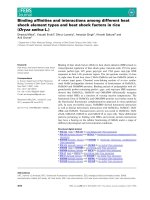
![Chemical and functional components in different parts of rough rice (oryza sativa l[1] ) beforeandaftergermination](https://media.store123doc.com/images/document/14/rc/qa/medium_qab1394872940.jpg)

